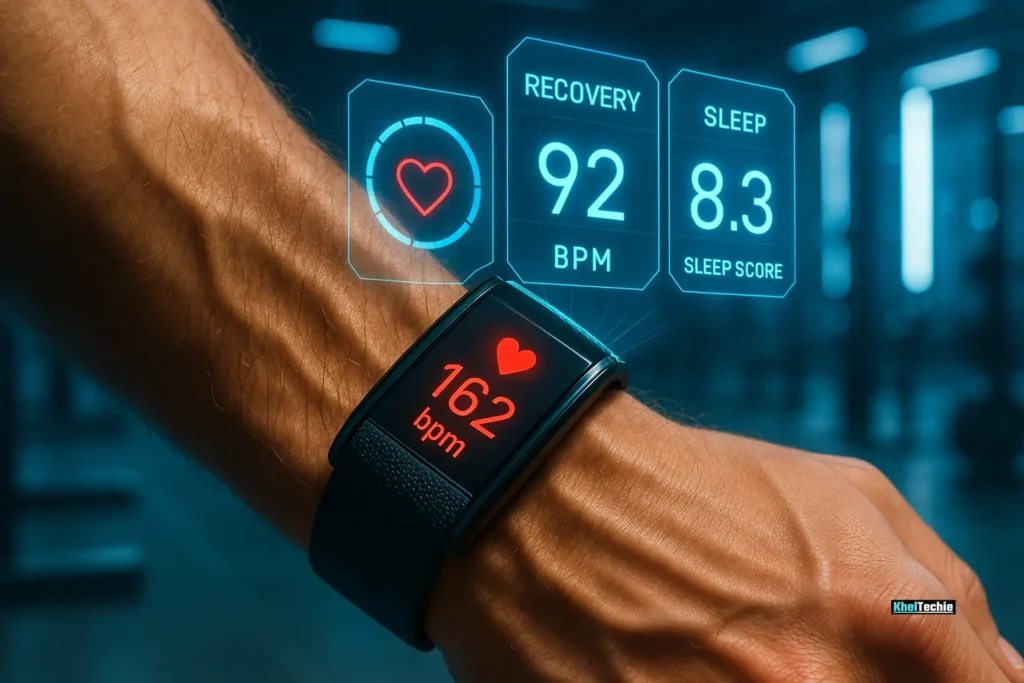Break Through Your Fitness Plateau: Proven 2025 Strategies to Reignite Progress
The Frustration You Know Too Well
You’ve been hitting the gym regularly, eating clean, and tracking every rep and calorie, yet the scale won’t budge, your strength gains have stalled, and motivation is slipping. Sound familiar?
Welcome to the world of fitness plateaus, that frustrating stage where progress seems to halt no matter how hard you try.
But here’s the good news, plateaus aren’t permanent. In fact, with the right 2025-approved strategies, you can not only break through them, you can turn them into launchpads for new personal bests.
In this article, we’ll walk you through:
- What causes a plateau
- Why it matters in 2025’s evolving fitness landscape
- Step-by-step methods to overcome it
- Common mistakes people make and how to avoid them
- Expert-backed advice and FAQs to answer every question you might have
Let’s get started.
Also read – The Best Fitness Gadgets for 2025

What Are Fitness Plateaus?
A fitness plateau occurs when your body adapts to your current workout regimen, leading to a stagnation in progress. This adaptation means that the same exercises and routines no longer challenge your body, resulting in halted improvements in strength, endurance, or weight loss.
The Body’s Adaptation Mechanism
Think of your body as a highly efficient machine. When introduced to a new challenge, it works hard to adapt. Once it becomes accustomed, the same challenge no longer elicits the same response. Just as a student needs progressively harder material to continue learning, your body requires new challenges to keep improving.
And in 2025, with more data-driven tools, smarter recovery methods, and personalized approaches, breaking through these plateaus isn’t just possible, it’s expected.

Why Overcoming Fitness Plateaus Matters in 2025
Let’s face it, consistency alone isn’t enough. Your body adapts, That’s why what worked six months ago might not work now.
Overcoming fitness plateaus is essential for maintaining progress, preventing injuries, and sustaining motivation. When your body adapts to a consistent workout routine, progress can stall, leading to frustration and potential setbacks. Implementing strategies such as varying your workouts, incorporating rest periods, and adjusting nutritional intake can help you break through these plateaus and continue advancing toward your fitness goals.
For instance, the American Heart Association recommends following the F.I.T.T. principle, Frequency, Intensity, Time, and Type, to introduce variety and challenge into your exercise regimen, thereby overcoming lulls in your physical activity routine.
Additionally, understanding that plateaus are a natural part of the fitness journey can help you approach them with a positive mindset. By recognizing when you’ve hit a plateau and proactively making changes to your routine, you can continue to see improvements in strength, endurance, and overall health.
Remember, consistency, adaptability, and a willingness to modify your approach are key to overcoming fitness plateaus and achieving long-term success in your fitness journey.
But here’s the silver lining: modern science, AI-assisted training plans, and better recovery protocols give us an edge our predecessors didn’t have.
Here’s why this topic matters now:
📈 2025 Trends Are Designed to Help You Break Through
- Personalized Training Apps: Platforms like Fitbit Premium and Apple Fitness+ now offer adaptive routines based on biometric feedback.
- Wearable Tech Evolution: Devices like Whoop and Garmin Venu track recovery, stress levels, and readiness to train, giving you real-time insights into when to push or pull back.
- Community-Based Coaching: Online platforms like TrainHeroic and Future provide access to certified coaches who adjust programs based on your performance.
- Mental Resilience Focus: Mindset training via apps like Headspace and Calm is now considered essential in long-term fitness success.

How to Beat a Fitness Plateau in 2025
Ready to start making progress again? Here’s a practical, step-by-step guide that combines expert knowledge, modern tools, and time-tested principles.
Step 1: Identify the Type of Plateau You’re Facing
There are different kinds of plateaus, each requiring a tailored strategy:
| Plateau Type | Signs | Solution |
|---|---|---|
| Strength | No increase in weights lifted | Increase volume, change rep ranges |
| Endurance | Can’t run longer or faster | Add HIIT, vary intensity |
| Body Composition | No fat loss or muscle gain | Adjust macros, increase NEAT |
| Motivation | Lack of drive or focus | Set micro-goals, find accountability |
Understanding which type you’re dealing with helps you apply the right fix.
Step 2: Switch Up Your Training Stimulus
Your muscles adapt fast. To shock them back into growth, you need variety.
Try These Techniques:
- Drop Sets: Finish your last set with decreasing weight without rest.
- Supersets: Pair two exercises back-to-back (e.g., push-ups + rows).
- Tempo Changes: Slow down the eccentric (lowering) phase of lifts.
- New Equipment: Use resistance bands, kettlebells, or even bodyweight variations.
If you always do barbell squats, switch to Bulgarian split squats or box jumps for a fresh stimulus.
Step 3: Track Everything — But Smarter
Gone are the days of guesswork. Now, use data to your advantage.
Tools to Use:
- MyFitnessPal or Cronometer – For macro tracking
- Apple Watch or Whoop – For heart rate variability (HRV) and recovery scores
- TrainingPeaks or Excel Sheets – For tracking lifting progress
- Sleep Monitors – Like OURA Ring or Fitbit Sleep Score
Don’t obsess over numbers. Look for trends over weeks, not days.
Step 4: Prioritize Recovery Like Never Before
This is the secret weapon most people overlook. In 2025, smart athletes know that recovery is where growth happens.
Recovery Practices to Adopt:
- Foam Rolling & Mobility Work: Helps reduce inflammation and improve range of motion.
- Cold Plunge Therapy: Shown to reduce DOMS (delayed onset muscle soreness).
- Breathwork & Meditation: Enhances parasympathetic nervous system activity.
- Sleep Optimization: Aim for 7–9 hours; consider blackout curtains and melatonin supplements if needed.
Step 5: Fuel Your Goals with Precision Nutrition
Macros are still king, but timing, quality, and individual needs matter more than ever.
Key Nutritional Tips:
- Carb Cycling: Alternate high-carb and low-carb days depending on workout intensity.
- Protein Timing: Get 20–30g of protein every 3–4 hours.
- Micronutrient Focus: Don’t neglect vitamins D, B12, magnesium, and iron.
- Hydration Tracking: Dehydration can mimic fatigue and poor performance.
Use apps like Chronometer or Lifted Nutrition to personalize your plan.
Step 6: Test, Not Guess, Leverage Biometrics
In 2025, biofeedback is king. Don’t assume, measure.
Biometric Tools to Consider:
- DEXA Scans – Accurately measures body fat, lean mass, and bone density.
- Blood Testing Kits – Services like InsideTracker analyze key biomarkers affecting performance.
- Heart Rate Variability (HRV) – Tells you if your body is ready to train hard or needs rest.
Get tested every 3–6 months to stay ahead of hidden issues.
Step 7: Build Mental Resilience
Physical plateaus often stem from mental ones. Burnout, lack of purpose, or unclear goals can stall progress.
Mindset Hacks:
- Set SMARTER Goals: Specific, Measurable, Achievable, Relevant, Time-bound, Exciting, Reviewed.
- Journal Daily: Reflect on wins, challenges, and adjustments.
- Visualize Success: Athletes use visualization to mentally rehearse performance.
- Find Accountability: Join a group or hire a coach for motivation and structure.

Common Mistakes People Make When Trying to Overcome Plateaus
Even with all the tools at your disposal, many people fall into traps that delay progress instead of speeding it up.
❌ 1. Doing the Same Thing Repeatedly and Expecting Different Results
Albert Einstein said it best: “Insanity is doing the same thing over and over and expecting different results.” If your program hasn’t changed in 3 months, it’s time for a revamp.
❌ 2. Cutting Calories Too Drastically
Dropping calories too fast can slow metabolism and cause muscle loss. Instead, use reverse dieting, gradually increasing intake to reset metabolic rate before cutting again.
❌ 3. Ignoring Sleep and Stress
High cortisol = stalled progress. If you’re stressed and sleep-deprived, your body doesn’t recover properly, and hormones go haywire.
❌ 4. Skipping Deload Weeks
Pushing non-stop leads to burnout. Schedule planned deload weeks every 4–6 weeks to let your body recover and come back stronger.
❌ 5. Chasing Quick Fixes
Detoxes, extreme diets, and miracle supplements rarely work long-term. Focus on sustainable habits instead.
Also read – Best Fitness Tracker for Women in 2025

Conclusion: Your Next Step Starts Today
Fitness plateaus aren’t signs of failure, they’re signals. They tell you it’s time to evolve.
With 2025’s cutting-edge tools, smarter recovery practices, and a deeper understanding of the mind-body connection, you have everything you need to push past the wall and reach new heights.
Now it’s your turn.
👉 Comment below with your biggest challenge or share your success story.
👉 Share this article with someone stuck in a rut, because progress is better together.
And remember, every great transformation has a plateau in the middle. Push through it, your breakthrough is closer than you think.
Note: This article is for informational purposes only and does not constitute medical advice. Always consult with a healthcare professional before making significant changes to your fitness or nutrition regimen.
Frequently Asked Questions
How long does a fitness plateau usually last?
Most plateaus last 2–6 weeks, but they can stretch longer if you don’t make changes. The key is to reassess every 3–4 weeks and tweak variables like intensity, volume, or nutrition.
Should I take a break if I hit a plateau?
Not necessarily, A de-load week (reducing intensity/volume) is better than full stoppage. This gives your CNS a reset without losing momentum.
Can changing my workout routine help me break a plateau?
Yes! Changing your routine every 4–6 weeks prevents adaptation. Even small tweaks like switching grip width or tempo can stimulate new growth.
Will adding cardio help me break a fat loss plateau?
If you’re already doing strength training, low-intensity steady-state (LISS) cardio like walking or cycling can help create a slight calorie deficit without burning out.
How do I know if I’m truly at a plateau?
Track metrics over time. If your strength, body composition, endurance, or energy levels haven’t improved in 3–4 weeks despite consistent effort, you’re likely in a plateau.
Does hydration affect plateaus?
Absolutely, Even mild dehydration can reduce strength output by up to 10% and impair recovery. Aim for at least 2.5–3 liters per day.
Can a supplement help me break a plateau?
Some supplements may support progress:
- Creatine Monohydrate – Boosts strength and power
- Caffeine – Increases energy and focus
- Electrolytes – Supports hydration and muscle function
Always consult a healthcare provider before starting any supplement.
How important is sleep in overcoming a plateau?
Very, during deep sleep, your body releases growth hormone, repairs tissues, and balances hormones like testosterone and cortisol.
Aim for 7–9 hours nightly, and consider using a sleep tracker to monitor quality.
Can changing my mindset help me break through a plateau?
Yes, many plateaus are mental. Reframing your goals, practicing gratitude, and celebrating small wins can reignite motivation and performance.
What’s the fastest way to break a plateau?
The fastest way is a combo of:
- Changing your workout stimulus
- Tracking and adjusting nutrition
- Prioritizing recovery and sleep
- Using biometric feedback to guide decisions
It’s not magic — it’s methodical.





Pingback: Best HIIT Workouts For Weight Loss That Burn Fat Fast
Pingback: How To Create Personalized Workout Calendar (2025 Edition)